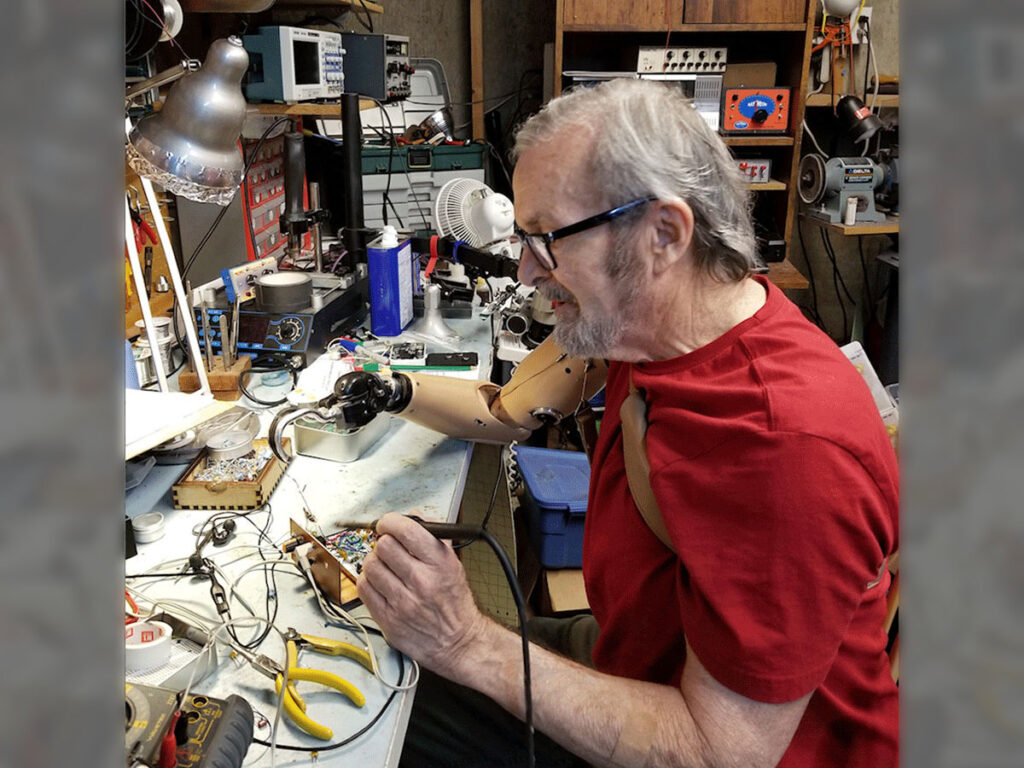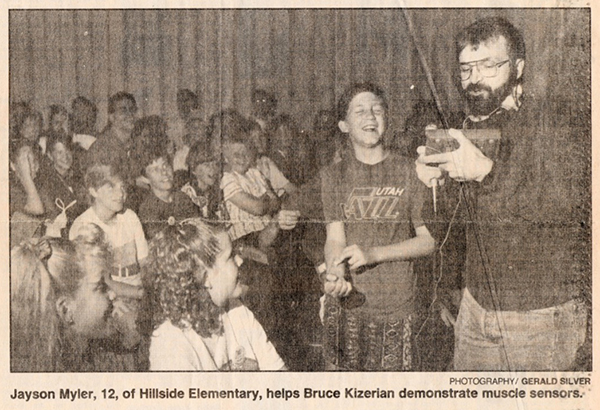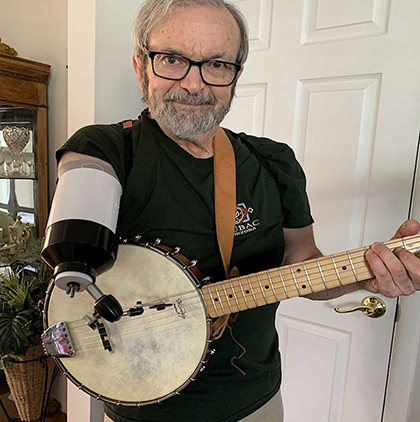I met Bruce at a Fillauer MyoU Course in Salt Lake City where he was involved as a transhumeral patient volunteer for the session. I was told he was someone I should get to know—and I’m glad I did! He has a fascinating story with ties to the early origins of the Utah Arm.

Growing up in Utah, Bruce loved tinkering—especially with short-wave radio, an interest that eventually led to the creation of a small company called Elmer Radio to teach kids about radio theory and construction. Over time he assembled and sold (or gave away) over 1000 crystal radio kits. He didn’t earn much money, but he had fun and learned a lot. After high school he expanded his interests and built his own 8” reflecting telescope from hardware store parts so he could see the stars.
Bruce received his degree in education, but worked his way through college as an electronics technician and found he had a knack for building things. After returning from Vietnam, he decided he could make more as a tech than he could as a teacher, so he stayed with it taking some electronics courses by correspondence in the evenings.
He worked with the electronics research department at the University of Utah for a couple of decades. While there he built parts for ultra-high-speed cameras and had the opportunity to work on projects with Symbion and Robert Jarvik, the inventor of the first artificial heart.
He’s had the opportunity to work with some amazing modern technology right as it was being developed, including redesigning part of the processing circuit for a new cochlear implant and development of audio recording and digital signal processing.

While he was at the University, Bruce became friends with Dr. Stephen Jacobsen and Harold Sears who were developing a microprocessor-controlled prosthetic, the Utah Arm. They needed someone willing to take their new device into local schools to show off the technology and promote the field of engineering and science to students. Bruce’s background in education was a perfect fit. At that same time, Hollywood was introducing bio-mechanical characters like Steve Austin (the Six Million Dollar Man), Darth Vader, and Luke Skywalker’s realistic new bionic hand. This created even more excitement for the students when Bruce showed them similar technology that was being designed for amputees; even though he told them, “We still have a way to go”.
Later in his career Bruce moved with Sarcos, a spin off company from the University research department which designed products for vital sign monitoring and robotics. He had security clearance from his time in Vietnam, so he was given the chance to work on several small security level products including a micro-miniature video camera for medical and industrial use. Chuckling, he says he had the opportunity to work on some of the “weirdest and quirkiest little things that he couldn’t tell anybody about”.
After Bruce retired, he volunteered and became a resident engineer at the Leonardo Museum in downtown Salt Lake City where he created a STEM program for kids. He designed little cardboard machines for the kids to build and play with along with other engineering and music-based projects. He hosted the Utah Recycling Alliance’s “Fixit Clinics” where people brought in old lamps, vacuum cleaners, and other household items that needed repair. He also loved working with autistic young adults that would come in as part of a job training program the museum offered. He loved the challenges of the job.
Ironically, the man who helped present that early Utah Arm to the public was now in need of one.
During this time he was diagnosed with cancer in his hand and lower arm, which he lost in 2020. He hasn’t let that stop his tinkering or his volunteer work. His basement workshop is full of tools, radio parts, circuits, and equipment which he’s learning to manage with his hook and prosthetic elbow. Ironically, the man who helped present that early Utah Arm to the public was now in need of one.
Losing his arm may have slowed him down, but it never stopped him. Bruce still participates in the local ham radio club in his city as part of the Community Emergency Response Team (CERT) and does regular training with the fire department.

One of Bruce’s post-amputation hobbies has been designing himself a hearing aid that currently resides in an Altoids tin; he eventually plans to get it small enough to fit behind his ear. He has also rebuilt a 100-year-old banjo and, thanks to a custom attachment to his arm, can still play.
His latest ambitious project has been to design a circuit that will allow him to use the muscles in his remaining right arm to interface with a Morse code keyer which will allow him to operate his ham radio transceiver and simultaneously take notes with his left hand. Bruce also has fun making crystal radio kits and simple little robots for all his grandkids, and he loves to read books and articles about new technologies.
“Don’t give up and try things even if you think it’s impossible. I’ve had some things that have taken me 100 times longer to learn how to do, so don’t be in a hurry. Whatever you want to do you can figure it out. Stay active and force yourself to keep doing things you love.”
Bruce’s fascinating history and attitude toward his own limb-loss is motivating and inspiring. “Don’t give up and try things even if you think it’s impossible”, Bruce remarked. “I’ve had some things that have taken me 100 times longer to learn how to do, so don’t be in a hurry. Whatever you want to do you can figure it out. Stay active and force yourself to keep doing things you love.” We know that Bruce will continue to build new gadgets and friendships as he learns to navigate life as an amputee and cancer survivor.
